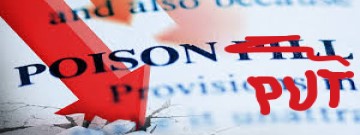
A poison put is an M&A defense strategy against a hostile takeover. The target company issues bonds that investors can redeem before their maturity date for an elevated price. This type of strategy is known as a shark repellent or pre-offer defense mechanism. The term Poison Put is a reference to the Poison Pill defense combined with the investors ability to “put” the bonds back to the target firm.
Poison puts have their origins in the hostile takeover boom of the late 1980’s. The constant threat of a leveraged buyout financed by junk bonds forced companies into adopting new measures to maintain corporate control. They have been discussed and analyzed in academia since that time. In their 1994 paper “Poison Put Bonds: An Analysis of Their Economic Role“, published in the Journal of Finance, Douglas O. Cook and John C. Easterwood state
A CONTRACTUAL INNOVATION, KNOWN generically as “poison puts” or “super poison puts,” has been introduced in the corporate bond market in recent years. The two principal covenants devised are put options and coupon adjustments triggered by the occurrence of “risk events” like hostile takeovers, acquisition of large stakes in firms (e.g., 30 percent), leveraged buyouts, and leveraged recapitalizations.
Although sometimes incorrectly referred to as a type of poison pill (shareholder rights plan), poison put does seek to achieve the same outcome. Both are shark repellents, or defensive strategies used in mergers & acquisitions. Additionally, both aim to make the prospect of acquiring the target company through a hostile takeover bid prohibitively expensive. A target company anticipating a hostile takeover approach can initiate a poison put defense by issuing new debt via a bond issue to investors. Investors are given the option of obtaining repayment in the event that a hostile takeover occurs before the bond’s maturity date. The right of early repayment is written in the bond’s covenant. In this instance, the triggering “event” is the takeover. Naturally, this defense will cause the merger arbitrage spread to be wider than it might otherwise have been.
This type of takeover defense is legal, although company executives and the board of directors have a fiduciary duty to act in the best interest of shareholders such as maximizing shareholder value. They must also carefully review any legal issues. Likewise, if the target firm employs the poison put defense strategy, the acquirer must carefully assess the total cost of acquisition of the target company. This includes other related costs such as the target’s debt payments. If necessary, additional measures and financing sources must be secured in order to ensure it possesses enough cash to cover the enlarged acquisition cost.
Benefits of a Poison Put
During a hostile bid approach, the acquiring firm, whether it is a rival company or activist investor attempts to gain control of a publicly traded company without the approval of the company’s board of directors. Acquirers must balance the cost of acquiring a controlling interest in the target company including the potential additional acquisition cost versus the profitability of the deal.
The put directly impacts the amount of cash that an acquired company has in the bank and brings forward the bond obligations from a future date to the present when the hostile takeover occurs. The acquiring company has be certain it has sufficient cash resources to cover the immediate repayment of bonds. A poison put is enacted at the time of the event, in this case the hostile buyout or change of ownership. It therefore differs from the poison pill (flip in or flip over) defenses in the following ways
- it does not affect the number of shares available on the stock market
- the put does not affect the price of shares (theoretically)
- voting rights afforded to shareholders are unaffected
The poison put strategy is not be a suitable defense tactic for every company. If the target company’s balance sheet is already weakened by carrying a substantial amount of outstanding debt, the poison put strategy could further jeopardize its financial situation and lead to its potential demise. In this case, the board of directors may prefer to negotiate with the acquirer. By rescinding the put, a pathway to a friendly takeover may be possible.
